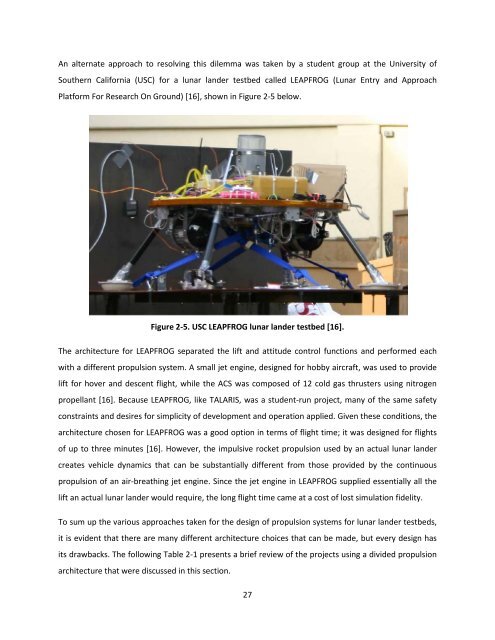Development of a Cold Gas Propulsion System for the ... - SSL - MIT
Development of a Cold Gas Propulsion System for the ... - SSL - MIT
Development of a Cold Gas Propulsion System for the ... - SSL - MIT
You also want an ePaper? Increase the reach of your titles
YUMPU automatically turns print PDFs into web optimized ePapers that Google loves.
An alternate approach to resolving this dilemma was taken by a student group at <strong>the</strong> University <strong>of</strong><br />
Sou<strong>the</strong>rn Cali<strong>for</strong>nia (USC) <strong>for</strong> a lunar lander testbed called LEAPFROG (Lunar Entry and Approach<br />
Plat<strong>for</strong>m For Research On Ground) [16], shown in Figure 2-5 below.<br />
Figure 2-5. USC LEAPFROG lunar lander testbed [16].<br />
The architecture <strong>for</strong> LEAPFROG separated <strong>the</strong> lift and attitude control functions and per<strong>for</strong>med each<br />
with a different propulsion system. A small jet engine, designed <strong>for</strong> hobby aircraft, was used to provide<br />
lift <strong>for</strong> hover and descent flight, while <strong>the</strong> ACS was composed <strong>of</strong> 12 cold gas thrusters using nitrogen<br />
propellant [16]. Because LEAPFROG, like TALARIS, was a student-run project, many <strong>of</strong> <strong>the</strong> same safety<br />
constraints and desires <strong>for</strong> simplicity <strong>of</strong> development and operation applied. Given <strong>the</strong>se conditions, <strong>the</strong><br />
architecture chosen <strong>for</strong> LEAPFROG was a good option in terms <strong>of</strong> flight time; it was designed <strong>for</strong> flights<br />
<strong>of</strong> up to three minutes [16]. However, <strong>the</strong> impulsive rocket propulsion used by an actual lunar lander<br />
creates vehicle dynamics that can be substantially different from those provided by <strong>the</strong> continuous<br />
propulsion <strong>of</strong> an air-breathing jet engine. Since <strong>the</strong> jet engine in LEAPFROG supplied essentially all <strong>the</strong><br />
lift an actual lunar lander would require, <strong>the</strong> long flight time came at a cost <strong>of</strong> lost simulation fidelity.<br />
To sum up <strong>the</strong> various approaches taken <strong>for</strong> <strong>the</strong> design <strong>of</strong> propulsion systems <strong>for</strong> lunar lander testbeds,<br />
it is evident that <strong>the</strong>re are many different architecture choices that can be made, but every design has<br />
its drawbacks. The following Table 2-1 presents a brief review <strong>of</strong> <strong>the</strong> projects using a divided propulsion<br />
architecture that were discussed in this section.<br />
27







